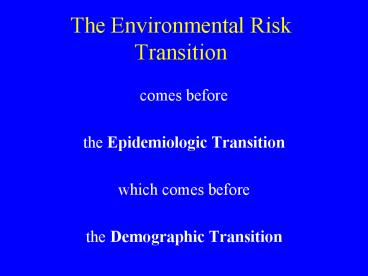The Environmental Risk Transition - PowerPoint PPT Presentation
1 / 37
Title:
The Environmental Risk Transition
Description:
Risk Genesis: new types of risk created ... Risk Synergism: risk of one type changes sensitivity to other risks. Increasing Wealth ... – PowerPoint PPT presentation
Number of Views:166
Avg rating:3.0/5.0
Title: The Environmental Risk Transition
1
The Environmental Risk Transition
- comes before
- the Epidemiologic Transition
- which comes before
- the Demographic Transition
2
(No Transcript)
3
(No Transcript)
4
(No Transcript)
5
(No Transcript)
6
(No Transcript)
7
Traditional Diseases, e.g. infectious
Modern, e.g. non-communicable
Non-transitional, e.g., injuries
8
The Environmental Risk Transition
Traditional Risk
Risk
Development
9
(No Transcript)
10
The Environmental Risk Transition
Traditional Risk
Risk
Modern Risk
Development
11
Smoking and Lung Cancer in Brazil
20-30 year time lag
Cigarettes/adult
Male Lung Cancer
1980
1940
12
The Environmental Risk Transition
Traditional Risk
Risk
Modern Risk
Risk Overlap
Development
13
The Risk Overlap
- Risk Genesis new types of risk created
- Risk Transfer attempts to control one type can
make other types worse - Risk Synergism risk of one type changes
sensitivity to other risks
14
(No Transcript)
15
The Kuznets Curve
Inequity
Increasing Wealth
Simon Kuznets, Nobel Economist, writing about 1960
16
The Kuznets Environmental Curve
Pollution
Increasing Wealth
17
The Environmental Kuznets Curve Urban Air
Pollution and Development
18
The Environmental Risk Transition
Household Sanitation
Urban Pollution
Severity
Increasing Wealth
Shifting Environmental Burdens
Local
Community
Immediate
Delayed
Risks to Human Health
Risks to Life Support Systems
19
The Full Environmental Risk Transition
Household Sanitation
Urban Pollution
Severity
Greenhouse- gas emissions
Increasing Wealth
Shifting Environmental Burdens
Local
Global
Immediate
Delayed
Risks to Human Health
Risks to Life Support Systems
20
How Much Ill-Health can be Attributed to
Environmental Factors?
21
Almost 10 of the Entire Global Burden of Disease
is Due to 3 Environmental Diseases inJust 2
Regions
Source World Health Report, 2001
22
How Much Ill-Health can be Attributed to
Environmental Factors?
- What do we mean by ill-health?
- What do we mean by environmental?
- What do we mean by attributed?
23
Ill-Heath?
- Lost healthy life years - DALY
- As tabulated in the Global Burden of Disease
24
Environment?
- Everything
- Non-Genetic
- And Non-Behavioral
- And Non-Social
- And Non-Natural
25
Natural Environmental Hazards
- Constant search for sufficient food and water
while avoiding natural toxins - Infections and parasites that spread from person
to person or animal to person - Dust, damp, woodsmoke, pollen, and other airborne
hazards - Injuries from falls, fires, and animals
- Heat, cold, rain, snow, wind, natural disasters,
and other adverse conditions
26
Environmental Factor?
- Everything
- Non-genetic
- Non-Behavioral
- Non-Social
- Non-Natural
- Everything non-genetic, not behavioral,
non-social, non-natural, where there is a
measurable physical, chemical, or biological
agent passing through environmental pathways to
reach humans
27
(No Transcript)
28
Attributable Risk?
- The amount of ill-health that would not exist
today if the exposure to the risk factor had not
occurred in the past. - Assumes all other risk factors remain constant
- Counter-factual level important, i.e., what lower
exposure level would have been possible?
29
Characteristics of Attributable Risk
- All attributable risks for a disease often add up
to much more than 100 - Size of attributable risk for a particular risk
factor depends on order that different factors
are examined - Presumes the existence of a feasible intervention
to lower exposure.
30
How attributable risks can add to more than 100
31
Attributable Risks
Malnutrition 35
Better Housing 40
Breastfeeding 10
3 million ARI Deaths in Children Under 5
Diarrhea 20
Air Pollution 30
Measles 10
Case-management 65
Vaccines 25
Rough estimates only
32
General Principles of EBD Determination
- Environmental control is a viable intervention
- Environmental control taken first, i.e.,
prevention is emphasized - As with nutrition, recovery from all
diseases/injuries can be delayed by poor
environment. (5 minimum for all diseases)
33
Exclusions
- Genetic risk factors
- Diet, but do include food additives and
contamination - Active smoking, but do include passive smoking
- Sexual behavior, alcohol, drug abuse, and
criminal violence
34
Inclusions
- All workplace injuries/diseases, including those
in the military - Household, community, and larger-scale behavioral
factors related to hygiene - Road accidents, falls, drownings
- Housing complex, combination of
crowding/ventilation/chilling/drainage - Natural disasters
35
Environmental Brden of Disease
Environmental Burden of Disease 25-40 of total
Percent of Total
36
(No Transcript)
37
Thank you































